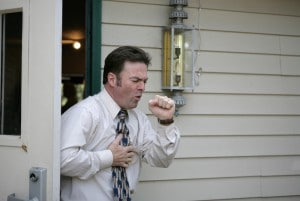The Sick Building Syndrome
The Sick Building Syndrome
 Three more co-workers called in sick today. Just a flu bug? Or the dreaded sick building syndrome?
Three more co-workers called in sick today. Just a flu bug? Or the dreaded sick building syndrome?
Modern commercial buildings are made as weather-tight as possible to promote energy efficiency. Windows don’t open any more; light is artificial, not natural. And central air conditioning means everyone is sharing the same air, over and over. Is that healthy? The EPA estimates that indoor air is five to six times more polluted than outdoor air, and polluted air causes 94% of all respiratory problems. Wouldn’t you like to know that the air you and your co-workers breathe is healthy? There’s an easy way to find out!
The AirAdvice monitor http://www.airadvice.com can remotely track the quality of the indoor air within your facility. It does so unobtrusively and tracks six different categories of indoor air pollution. The results are sent via e-mail and include charts and graphs that give you answers in a clear and straightforward format.
Particulate matter (allergens, bacteria, dust) can aggravate asthma, cause sickness and otherwise disrupt the lives of your co-workers. Volatile organic chemicals like benzene and formaldehyde can run you afoul of state and federal requirements regarding material safety and air quality. Carbon monoxide is an odorless, toxic gas that occurs in any building that uses appliances running on gasoline or natural gas (such as your water heaters or forklifts). Carbon dioxide, while rarely harmful, can result in drowsiness and lost productivity.
And what about your building’s ductwork? 50% of all major office buildings have contaminated duct systems. If not properly maintained, they can be a hotbed for growth of molds and bacteria. By keeping up with your preventative maintenance program, you reduce your exposure to indoor air quality problems.
The good news is that 90% of the AirAdvice tests show that your building is in fine mettle, with no concentrations of harmful or nuisance pollutants. You have the peace of mind knowing that you’ve taken action to confirm that you and your co-workers are safe from Sick Building Syndrome. You have a detailed report on file, ready to show your diligence if questions do come up.
And if it turns out there is a problem, you’re the first one to find it and you can take quick action to remedy it. Frequently, any pollution source can be easily relocated to a safe spot. Building ventilation can be increased, and any leaky ducts that are pulling in pollution (say, forklift exhaust fumes from the warehouse) can be sealed.
Don’t let a potentially nasty problem catch you unawares. Have the air in your building sampled with the AirAdvice monitor. Let your staff know you take their health and well-being seriously.
